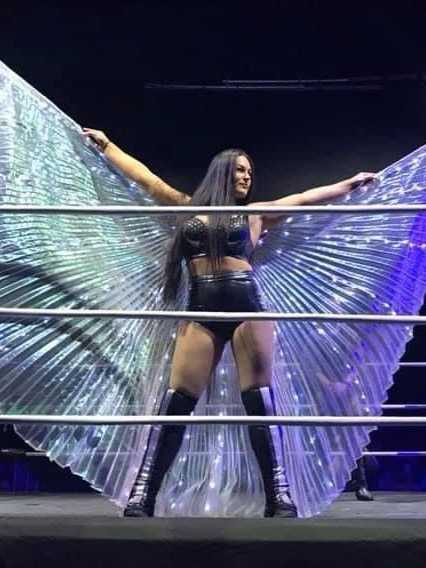When Amy Douglas first started on the independent pro-wrestling scene almost 20 years ago, she struggled to find outfits and had to source them from “weird places”, including a shop that specialised in custom bathers.
“It wasn’t nice, but I was like, ‘I’ve got something, I guess’,” she said.
So Ms Douglas dusted off her sewing machine and began making her own wrestling gear.
As her seamstress skills developed, she started making costumes for other wrestlers too.
Bronson Reed is among Ms Douglas’s clients. (Supplied: Amy Douglas)
Fast forward 15 years and she has now has a successful business with clients that have included Adelaide’s own World Wrestling Entertainment (WWE) star Rhea Ripley, Victorian wrestler Indi Hartwell, and South Australian Bronson Reed.
Ms Douglas, who performs as Savannah Summers, said women’s costumes can cost upwards of $300 but she did not make wrestling gear for profit.
“I just love wrestling and I want to help out the industry pretty much, because there’s not many people that do it,” she said.
Fellow Adelaide wrestler Ash also had to make her own costumes when she began in the industry, using her skills honed through her cosplay hobby.
Ash, who goes by the stage name of Axe Massacre, said she was soon making costumes for others too.
Axe Massacre (left) started making her own wrestling gear when she couldn’t find anything suitable. (Supplied: Justin White)
“I told one person that I was going to make my own gear and when they found out that I could sew, it kind of snowballed from there,” she said.
Ash said the importance of a wrestler’s image should not be underestimated.
“If you come out and you look boring or you look silly, or like what you’re wearing doesn’t match the character that you’re trying to put out there … people aren’t going to be interested or they’re going to be very confused,” she said.
Costumes ‘make or break’ character
It was not just female wrestlers who had to create their own costumes in the early days.
Travis Cleves, who performs as Jett Armstrong, said what wrestlers wear was just as important as creating memorable moments in the ring.
“A stand-out costume can either make or break your character,” he said.
But 20 years ago, he and his brother, who wrestles as Nick Armstrong, had to source their costumes from wedding dress designers.
“They’d never done a wrestling costume before, but they knew how to sew and do some kind of cool looking things,” he said.
“We gave them as much guidance as we knew how to, but at the end of the day, I’m a lot more happy now that we have actual wrestling gear designers that know exactly what they’re doing.”
Travis Cleves says he used to source his costumes from a wedding dress designer. (Supplied: Jaidyn Maidment)
Mr Cleves said he was glad up-and-coming wrestlers now have more options, and said they were achieving what he could “only dream of” when he first started.
“These days we have a lot of really good designers for the costumes here in South Australia, and all over Australia,” he said.
And, he said, the industry overall was “growing phenomenally”.
“People leave here just feeling fantastic after a show and that’s why we do it,” he said.




